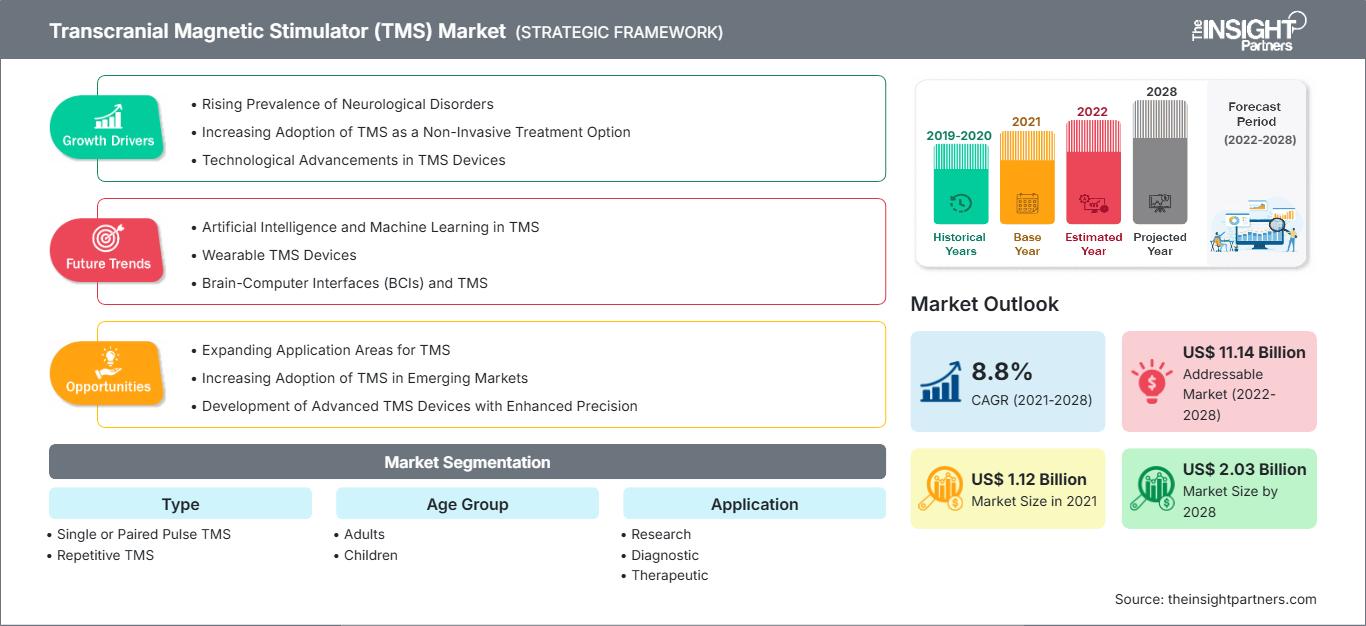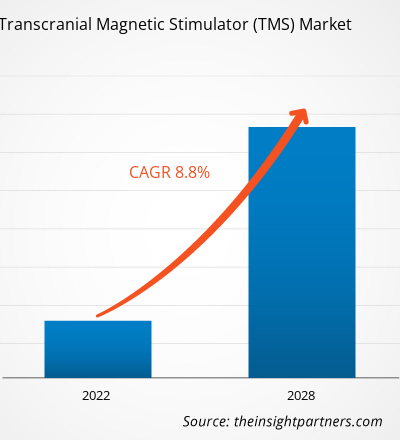[Informe de investigación] Se prevé que el mercado de estimuladores magnéticos transcraneales (EMT) alcance los 2.029,71 millones de dólares estadounidenses en 2028, frente a los 1.122,22 millones de dólares estadounidenses en 2021; se espera que registre una tasa de crecimiento anual compuesta (TCAC) del 8,8% entre 2021 y 2028.
Los trastornos neurológicos afectan al cerebro y los nervios del cuerpo humano y causan, entre otras afecciones, epilepsia y convulsiones, enfermedad de Parkinson, demencia, autismo, enfermedad de Alzheimer, tumores cerebrales y parálisis cerebral. La prevalencia de los trastornos neurológicos está aumentando en todo el mundo. Según el Estudio de la Carga Mundial de Morbilidad (GBD) de 2017, la enfermedad de Alzheimer y otras demencias (2,55 millones de años de vida ajustados por discapacidad [AVAD]), el accidente cerebrovascular (aproximadamente 3,58 millones de AVAD) y la migraña (aproximadamente 2,40 millones de AVAD) fueron las tres enfermedades neurológicas con mayor carga de morbilidad en Estados Unidos en términos del número total de años de vida ajustados por discapacidad.
Además, la Asociación de Alzheimer estima que más de 6 millones de estadounidenses padecen la enfermedad de Alzheimer, y se prevé que esta cifra alcance casi los 13 millones para 2050. La estimulación magnética transcraneal (EMT) se utiliza ampliamente para el diagnóstico y tratamiento de trastornos neurológicos. Por ejemplo, según BrainsWay Ltd., en abril de 2021, 100 000 pacientes de todo el mundo recibieron tratamiento con su sistema Deep TMS. Así pues, la creciente prevalencia de los trastornos neurológicos impulsa el crecimiento del mercado de la estimulación magnética transcraneal (EMT) a nivel mundial. Asimismo, la depresión es uno de los trastornos mentales más comunes en todo el mundo. Según datos publicados por la OMS en enero de 2020, más de 264 millones de personas de todas las edades sufren depresión en todo el mundo.
Obtendrá personalización gratuita de cualquier informe, incluyendo partes de este informe, análisis a nivel de país y paquetes de datos de Excel. Además, podrá aprovechar excelentes ofertas y descuentos para empresas emergentes y universidades.
Mercado de estimuladores magnéticos transcraneales (EMT): Perspectivas estratégicas

- Obtenga las principales tendencias clave del mercado que se describen en este informe.Esta muestra GRATUITA incluirá análisis de datos, que abarcarán desde tendencias de mercado hasta estimaciones y pronósticos.
Perspectivas del mercado
La estimulación magnética transcraneal (EMT) es un procedimiento no invasivo que ayuda a tratar trastornos neurológicos. Además, los avances tecnológicos en EMT han ampliado sus aplicaciones. Las empresas que operan en el mercado de la estimulación magnética transcraneal (EMT) están adoptando diversas estrategias, como la obtención de aprobaciones de la Administración de Alimentos y Medicamentos (FDA) para sus productos innovadores, el establecimiento de alianzas comerciales y la captación de fondos para el desarrollo de productos, lo que impulsa el crecimiento del mercado.
A continuación se presentan algunos ejemplos de avances:
- En marzo de 2021, MagVenture presentó el MagVenture Flow Arm, un sistema de posicionamiento clínico con patente en trámite, diseñado para optimizar la aplicación de los protocolos de MagVenture aprobados por la FDA para la tecnología de estimulación cerebral no invasiva para el tratamiento del trastorno depresivo mayor y como terapia complementaria para el trastorno obsesivo-compulsivo (TOC).MagVenture introduced the MagVenture Flow Arm—a patent-pending, clinical positioning system—designed to optimize the delivery of MagVenture's FDA-cleared protocols for noninvasive brain stimulation technology for the treatment of major depressive disorder and as an adjunct therapy for obsessive compulsive disorder (OCD).
- En agosto de 2020, la terapia MagVenture TMS recibió la autorización de la FDA para el tratamiento complementario del TOC. Es la segunda indicación en EE. UU. para la empresa danesa de dispositivos médicos MagVenture.MagVenture TMS Therapy received FDA clearance for the adjunct treatment of OCD. It is the second indication in the US for the Danish medical device company MagVenture.
- En febrero de 2019, eNeura, Inc., una empresa privada de tecnología médica, anunció una nueva autorización 510(k) de la FDA. Con esta autorización, la empresa afirmó que su sistema sTMS es el único producto para la migraña en EE. UU. para el tratamiento de las migrañas agudas y profilácticas en adultos y niños (a partir de 12 años).
Por lo tanto, se espera que la participación activa de los actores globales en el desarrollo de la estimulación magnética transcraneal y tecnologías relacionadas respalde el crecimiento del mercado.
Perspectivas basadas en tipos
Según su tipo, el mercado de la estimulación magnética transcraneal (EMT) se divide en EMT de pulso único o doble y EMT repetitiva (EMTr). En 2021, el segmento de EMT de pulso único o doble representó la mayor parte del mercado. Sin embargo, se prevé que el segmento de EMTr experimente una mayor tasa de crecimiento anual compuesto (TCAC) durante el período 2021-2028.
Información basada en aplicaciones
Según su aplicación, el mercado se segmenta en investigación, diagnóstico y terapia. En 2021, el segmento de diagnóstico representó la mayor cuota de mercado y se prevé que experimente el mayor crecimiento anual compuesto (CAGR) en los próximos años.
Las empresas que operan en el mercado de la estimulación magnética transcraneal (EMT) hacen hincapié en la adopción de una estrategia de innovación de productos para satisfacer las cambiantes demandas de los clientes en todo el mundo, lo que también les permite mantener su prestigio de marca a nivel global.
Estimulador magnético transcraneal
Perspectivas regionales del mercado de estimuladores magnéticos transcraneales (EMT)
Los analistas de The Insight Partners han explicado en detalle las tendencias regionales y los factores que influyen en el mercado de la estimulación magnética transcraneal (EMT) durante el período de previsión. Esta sección también analiza los segmentos del mercado de la EMT y su distribución geográfica en Norteamérica, Europa, Asia Pacífico, Oriente Medio y África, y Sudamérica y Centroamérica.
Alcance del informe de mercado de estimuladores magnéticos transcraneales (EMT)
| Atributo del informe | Detalles |
|---|---|
| Tamaño del mercado en 2021 | 1.120 millones de dólares estadounidenses |
| Tamaño del mercado para 2028 | US$ 2.030 millones |
| Tasa de crecimiento anual compuesto global (2021 - 2028) | 8,8% |
| Datos históricos | 2019-2020 |
| período de previsión | 2022-2028 |
| Segmentos cubiertos | Por tipo
|
| Regiones y países cubiertos | América del norte
|
| Líderes del mercado y perfiles de empresas clave |
|
Densidad de los actores del mercado de la estimulación magnética transcraneal (EMT): comprensión de su impacto en la dinámica empresarial.
El mercado de la estimulación magnética transcraneal (EMT) está creciendo rápidamente, impulsado por la creciente demanda de los usuarios finales debido a factores como la evolución de las preferencias de los consumidores, los avances tecnológicos y una mayor conciencia de los beneficios del producto. A medida que aumenta la demanda, las empresas amplían su oferta, innovan para satisfacer las necesidades de los consumidores y aprovechan las nuevas tendencias, lo que impulsa aún más el crecimiento del mercado.

- Obtenga una visión general de los principales actores del mercado de la estimulación magnética transcraneal (EMT).
Mercado de estimuladores magnéticos transcraneales (EMT) – Segmentación
Por tipo
- EMT de pulso único o doble
- Estimulación magnética transcraneal repetitiva (EMTr)
Por grupo de edad
- Adultos
- Niños
Mediante solicitud
- Investigación
- Diagnóstico
- Terapéutico
Por geografía
- América del norte
- A NOSOTROS
- Canadá
- México
- Europa
- Francia
- Alemania
- Italia
- Reino Unido
- España
- El resto de Europa
- Asia Pacífico (APAC)
- Porcelana
- India
- Corea del Sur
- Japón
- Australia
- Resto de Asia Pacífico
- Oriente Medio y África (MEA)
- Sudáfrica
- Arabia Saudita
- Emiratos Árabes Unidos
- Resto de Oriente Medio y África
- América del Sur y Central (ESTAFA)
- Brasil
- Argentina
- El resto es ESTAFA
Perfiles de empresas
- BrainsWay Ltd
- Nexstim, Magstim
- Neuronética
- Soluciones Neuro TMS
- MagVenture, Inc.
- eNeura Inc.
- Neurosoft
- MAG & More GmbH
- Análisis histórico (2 años), año base, pronóstico (7 años) con CAGR
- Análisis PEST y FODA
- Tamaño del mercado, valor/volumen: global, regional y nacional
- Industria y panorama competitivo
- Conjunto de datos de Excel
Informes recientes
Testimonios
Razón para comprar
- Toma de decisiones informada
- Comprensión de la dinámica del mercado
- Análisis competitivo
- Información sobre clientes
- Pronósticos del mercado
- Mitigación de riesgos
- Planificación estratégica
- Justificación de la inversión
- Identificación de mercados emergentes
- Mejora de las estrategias de marketing
- Impulso de la eficiencia operativa
- Alineación con las tendencias regulatorias




















 Obtenga una muestra gratuita para - Mercado de estimuladores magnéticos transcraneales (EMT)
Obtenga una muestra gratuita para - Mercado de estimuladores magnéticos transcraneales (EMT)